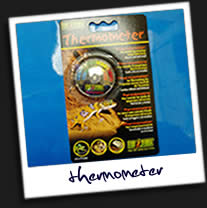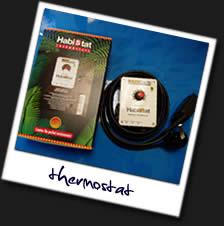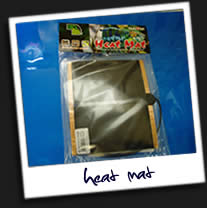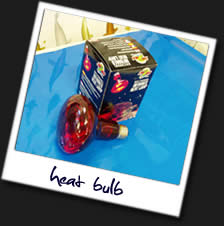www.reptiles-info.co.uk
Reptile Heating:
Reptile heating is an extremely important factor in the success of keeping a pet reptile. It can be one of the main reasons to ensure your reptile has a long and healthy life, however there are many factors involved in the process of heating a reptiles housing. In order to help you through the process of heating your reptiles housing we have provided a guide to reptile heating.
The Reason For Heating:
Due to the fact that the majority of reptiles come from warm climates it is necessary for you as a reptile keeper to replicate their natural living environment within the housing you have created for them. The reason for keeping a high temperature in your reptiles vivarium is because reptiles are ectothermic creatures that cannot regulate their own body temperature meaning that the use the environment they are in to heat their body. Not only does a warm temperature keep the reptiles warm it also aids the digestion process, thitefore it is imperative that you heat your reptiles vivarium correctly.

Temperature Gradient:
A reptiles cage should have a temperature gradient within its housing that allows for a warm and a cool area, this is to allow the reptile hosed within the tank to move to a temperature where they feel comfortable. The benefits of this mean that reptiles can move to the hot area of the tank after a meal so the heat can help them digest their food quicker. An average reptile temperature within a housing should be no cooler than 20°C and no warmer than 32°C to ensure a good temperature variation within the tank. A thermometer offers a good way to keep a constant eye on the temperature within your reptiles caging. For precise information on heating temperatures for your type of reptile visit the 'Categories' section of our website, in the housing section of this should be detailed information on your reptiles ideal housing temperature.
Hotspot:
A hotspot is an area within a reptiles housing that has a higher temperature than the rest of the reptiles tank, this helps to provide a temperature gradient as stated above. There are various ways in which to heat your tank in which to provide a hotspot many of the features are listed belowef
For More Information On Reptile Heating Click Here

Temperature Maintenance:
You can regulate the temperature within your reptiles housing by either using a thermometer in the cage that can inform you of the temperature within a specific area of the housing or for a more controlled way of heating your reptiles housing you can install a thermostat. The thermostat will self regulate the temperature in the housing so that it remains constant and to the correct temperature you have set. For More Information On Reptile Lighting Click Here
Heat Mats:

This is a way to produce a way of heating your reptiles vivarium from underneath the cage to maintain a constant heat for your reptile. The heat mat tends to warm items within the cage rather than the air. This action of heating is very similar to the sun and it has the ability to heat anything that is housed around the mat, however the air temperature is not greatly affected. Reptiles absorb this at in a manner very similar to basking in a natural enviroment. Heat mats do get warm but provide a very gentle warmth which the animal can sit under or on top of. Used under normal conditions the mats cannot burn the animal.

Ceramic Heaters:
This is a radiant heat source and creates a natural sun-like heat within your reptiles vivarium. The long wave infrared heat produced by this emitter will warm reptiles very efficiently. It also increases the ambient air-temperature in the terrarium. Infrared heat penetrates the scales and skin tissue, promoting health and healing as it widens the blood vessels and increases blood circulation. This is also an excellent way of providing heat to your reptile's enclosure over night as it emmits no visible UV rays.
Hot Rocks:
The Heat Wave Rock simulates a stone heated by the sun (in nature, even after sunset, stones maintain some heat for several hours). Various reptiles, including nocturnal, use this form of conductive heat for thermoregulation which is important for the reptiles metabolism and digestion. However i would advise you not to use hot rocks as they are prone to malfuncttion causing many reptiles to be burnt by the rock itself, therefore i advise you not to use a hot rock within your vivarium.

Basking Lamps:
Basking lamps are similar to a spot lamp in appearance. They differ in that the construction of the lamp provides for a concentrated vertical beam of heat energy. Standard spot lamps allow dissipation of heat over a wider area. Basking lamps, therefore, will concentrate their heat energy into a narrow band and reptiles will sit underneath this beam to absorb heat. If you choose to use a basking lamp you must remember to only leave the light on for 14hours a day in the summer and 8hours a day in the winter in order to keep the reptile's seasonal cycle in-tact.
For More Information On Reptile Lighting Please Click Here

Heat Bulbs:
A heat bulb enables you as a reptile keeper to focus more heat into your enclosure and minimizes night-time glare. A heat lamp is an excellent 24 hour heat source for all types of reptiles. When you switch on the heat lamp there is no visible light provided so this does not disturb any of your reptile's sleeping patterns.


